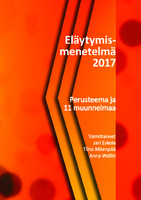Eläytymismenetelmä 2017
perusteema ja 11 muunnelmaa
| dc.contributor.editor | Mäenpää, Tiina | |
| dc.contributor.editor | Wallin, Anna | |
| dc.contributor.editor | Eskola, Jari | |
| dc.date.accessioned | 2017-12-14 00:00:00 | |
| dc.date.accessioned | 2020-04-01T13:20:14Z | |
| dc.date.available | 2020-04-01T13:20:14Z | |
| dc.date.issued | 2017 | |
| dc.identifier | 640598 | |
| dc.identifier | OCN: 1030820492 | en_US |
| dc.identifier.uri | http://library.oapen.org/handle/20.500.12657/30991 | |
| dc.description.abstract | "Tampere3 project, general knowledge, multicultural education, relocation of upper secondary school in a university campus, educational institution safety, wellbeing at work, successful recruitment process – these topics are discussed in eleven articles of this publication. The empirical data of these articles was collected during winter 2016-2017. Method of empathy based stories (MEBS) is a method for collecting qualitative data in which respondents write a story based on an orientation text, usually referred to as a frame story or a script. At least two different frame stories/scripts need to be formulated. MEBS data analysis is two-fold: firstly qualitative data analysis is based on the thematic framework of the research, furthermore the analysis imitates an empirical study and highlights the influence of the alteration of one factor in the frame story. MEBS has been utilized increasingly in various research fields in Finland since 1982. MEBS is in principle flexible and easy-to-use method, therefore it can be applied to explore a variety of research questions. The topics researched can be theoretically sophisticated and structured. They can be based on earlier research as well as to solve questions of more pragmatic nature. Despite the ostensible simplicity of using MEBS, many aspects need careful consideration and decisions need to be made especially in the data collection phase. So the last chapter of the publication concentrates on the formulation process of frame stories and data collection in an increasingly digitalized and diversified society. This publication is the first volume of the yearbook series introducing MEBS and research." | |
| dc.language | Finnish | |
| dc.subject.classification | thema EDItEUR::J Society and Social Sciences::JN Education | en_US |
| dc.subject.other | immigrants | |
| dc.subject.other | university of tampere | |
| dc.subject.other | all-round education | |
| dc.subject.other | integration | |
| dc.subject.other | universities | |
| dc.subject.other | recruiting | |
| dc.subject.other | students | |
| dc.subject.other | method of empathy based stories | |
| dc.subject.other | well-being at work | |
| dc.subject.other | knowledge of languages | |
| dc.subject.other | teachers | |
| dc.subject.other | schools | |
| dc.subject.other | higher upper secondary school | |
| dc.subject.other | educational institution safety | |
| dc.title | Eläytymismenetelmä 2017 | |
| dc.title.alternative | perusteema ja 11 muunnelmaa | |
| dc.type | book | |
| oapen.abstract.otherlanguage | "Tampere3-hanke, yleissivistys, maahanmuuttajien koulutus, lukion siirto yliopistokampukselle, oppilaitosturvallisuus, työhyvinvointi, onnistunut rekrytointiprosessi... Näitä kaikkia aiheita käsitellään teoksen 11 tutkimusartikkelissa, joiden empiirinen aineisto on kerätty eläytymismenetelmällä talvella 2016–2017. Eläytymismenetelmällä tarkoitetaan tiedonhankintamenetelmää, jossa vastaajat kirjoittavat kertomuksen tutkijan antaman, kehyskertomukseksi kutsutun orientaation perusteella. Kehyskertomuksia on aina vähintään kaksi erilaista ja aineisto analysoidaan kahteen kertaan: normaalina tutkimuksen tematiikasta kertovana laadullisena aineistona sekä kokeellisen tutkimuksen asetelmaa imitoiden ja pelkistäen sitä, mikä vastauksissa muuttuu, kun kehyskertomuksessa muutetaan yhtä keskeistä tekijää. Eläytymismenetelmää on käytetty eri tieteenaloilla yhä enenevissä määrin Suomessa vuodesta 1982 alkaen. Menetelmä sopii varsin monenlaisten tutkimusongelmien selvittämiseen joustavuutensa ja eräänlaisen kevytkäyttöisyytensä vuoksi. Aiheet voivat olla teoreettisesti jäsentyneitä ja aiemmasta tutkimuksesta ponnistavia mutta myös käytännön ongelmista inspiroituvia. Näennäisestä helppoudestaan huolimatta menetelmän käyttöön liittyy paljon pohdittavaa ja päätettävää erityisesti aineiston keräämisen vaiheessa. Eläytymismenetelmän käyttöä kehitetäänkin teoksen päättävässä menetelmäartikkelissa siitä näkökulmasta, miten menetelmälle keskeiset kehyskertomukset kannattaa muotoilla ja miten niiden avulla aineisto on kerättävissä digitalisoituvassa ja monikielistyvässä yhteiskunnassamme. Teos on ensimmäinen volyymi eläytymismenetelmää ja sillä toteutettavaa tutkimusta esittelevässä vuosikirjojen sarjassa. " | |
| oapen.relation.isPublishedBy | a58c317d-aa1d-4cda-913b-073587647c91 | |
| oapen.pages | 249 | |
| oapen.place.publication | Tampere | |
| oapen.remark.public | 21-7-2020 - No DOI registered in CrossRef for ISBN 9789520305970 | |
| oapen.identifier.ocn | 1030820492 |

